Home » Mattress Guides » Mattress Essentials » How Mattress Firmness Impacts Your Body and Mind
The Science of Sleep: How Mattress Firmness Impacts Your Body and Mind
Kamelia Foster
February 14, 2024
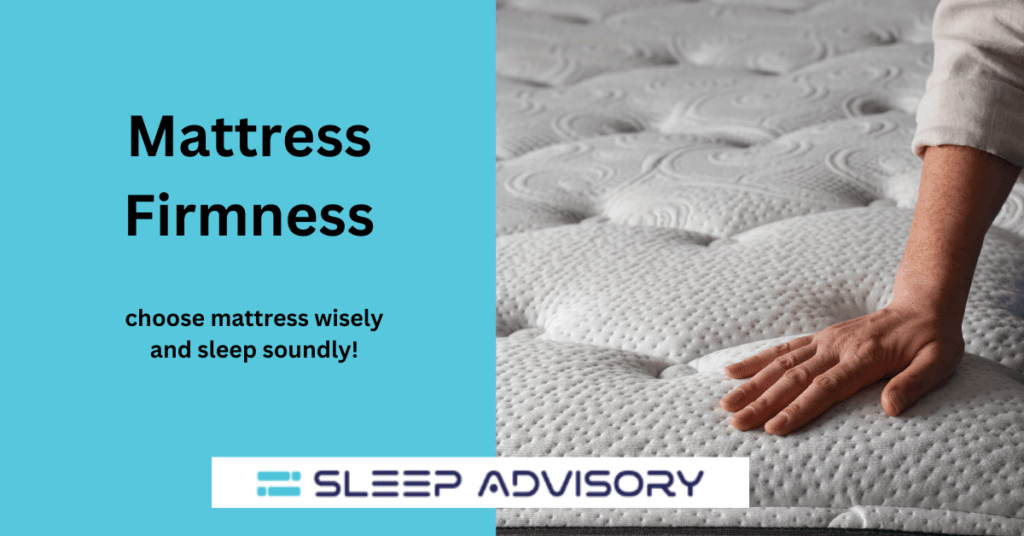
Do you ever toss and turn, counting sheep until dawn, longing for the sweet embrace of a perfect night’s sleep? The culprit might not be restless thoughts, but something much closer to home – your mattress. Yes, the very foundation of your slumber holds the key to unlocking a world of restful nights, and the key itself lies in mattress firmness.
Choosing the right mattress firmness is like finding the Goldilocks of beds – not too soft, not too hard, but just right. It’s a science, an art, and a journey of self-discovery. But fear not, weary traveler! This guide is your compass, ready to navigate the terrain of firmness scales, sleeping styles, and individual needs.
If you like sleeping on your side or stomach, we’ll help you understand mattress firmness. We’ll explain the materials and clear up common myths. You’ll learn how to choose the right firmness for your sleep. So, grab a pillow, get comfy, and let’s talk about getting better sleep with the right mattress.
Table of Content
Understanding Mattress Firmness
What Does "Universal Comfort" Mean?
“Universal comfort” for mattresses means they’re designed to feel just right for lots of people no matter how they like to sleep. It’s a kind of mattress that tries to make everyone happy!people. Not too soft and not too hard – like a middle ground that most folks find comfy,
Imagine you’re trying to pick a shirt for everyone in your class. It’s tough, right? Everyone has different styles and preferences! Similarly, “universal comfort” in mattresses doesn’t mean there’s one perfect firmness for everyone.
Instead, it’s like finding a “middle ground” firmness that most people find comfy. Think of it like a 5 or 6 on a 10-point scale where 1 is super soft and 10 is super firm. This “medium-firm” zone tries to offer enough support for different body types and sleeping styles (side, back, belly, etc.).
It’s not magic, though! Some people still might prefer softer or firmer, depending on their personal needs.
Here's a quick comparison:
- Soft mattress (1-3): Like sinking into a marshmallow, cozy but might not be supportive enough for everyone.
- Medium-firm mattress (5-6): The “universal comfort” zone, tries to please most people with a balance of support and softness.
- Firm mattress (7-10): Like sleeping on a sturdy board, great for back sleepers who need lots of support but might feel too hard for others.
Remember, mattress shopping is super personal! Trying different ones out in a store is the best way to find your own perfect comfort zone, even if it’s not the “universal” one
Why is Mattress Firmness Important?
Mattress firmness isn’t just about how it feels; it’s about finding a comfy and supportive balance for a good sleep.
Choosing the right level is important because it helps with:
- Keeping your back in a good position, so you don’t wake up with pain.
- Making sure your bed doesn’t press too hard on your body, avoiding aches and pains.
- Stopping movement from disturbing your sleep, even if your bed buddy moves a lot.
- Staying cool at night, which is especially helpful if you get hot when you sleep.
The Mattress Firmness Scale: A Deep Dive
Choosing the right mattress firmness is crucial for a good night’s sleep and long-term spinal health. But with terms like “plush,” “medium,” and “extra firm” thrown around, it can be confusing to navigate the mattress landscape. That’s where the mattress firmness scale comes in.
Understanding the Scale:
The mattress firmness scale typically ranges from 1 (softest) to 10 (firmest), with each number representing a specific level of sinkage and support. Here’s a breakdown of the general categories:
- 1-3: Extra Soft – Plush: These mattresses offer maximum cushioning and contouring, ideal for side sleepers who need pressure relief. Imagine sinking into a cloud-like embrace.
- 4-6: Medium – Medium Firm: The sweet spot for most sleepers, offering a balance of comfort and support. This range works well for back, side, and combination sleepers. Think of it as a hug that doesn’t suffocate.
- 7-8: Firm – Extra Firm: These mattresses provide minimal sinkage and prioritize spinal alignment, often preferred by back sleepers and those with back pain. Think of it as sleeping on a supportive platform.
- 9-10: Ultra Firm: The realm of heavy individuals and those seeking maximum support, often bordering on feeling like a firm bed frame. Think of it as sleeping on a sturdy surface with minimal give.
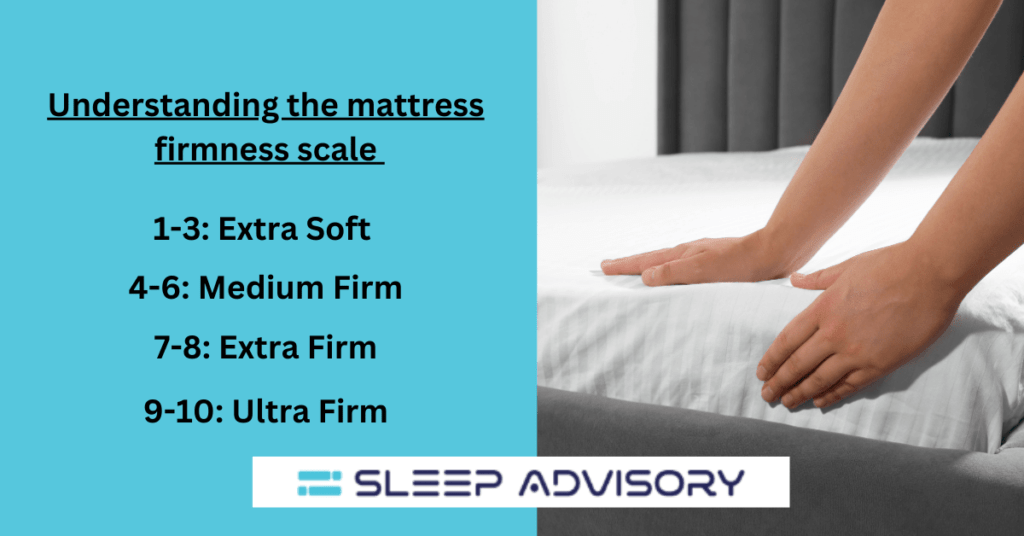
Beyond the Numbers:
Remember, the firmness scale is a guide, not a strict rule. How a mattress feels can vary depending on factors like:
- Your body weight and type:
Heavier individuals may need a firmer mattress for proper support, while lighter sleepers might prefer a softer one.
- Sleeping position:
Side sleepers typically need more pressure relief than back sleepers, so they may favor softer mattresses.
- Personal preference:
Some people simply prefer the feel of a softer or firmer bed, regardless of other factors.
Tips for Choosing the Right Firmness:
- Try before you buy:
If possible, test out different mattresses in a showroom to get a feel for their firmness. Lie in your usual sleeping positions and pay attention to how your body aligns and feels supported.
- Consider your needs:
Think about your body type, sleeping position, and any pain points you have. This will help you narrow down the firmness range that might be best for you.
- Ask an expert:
Don’t hesitate to seek advice from a sleep specialist or salesperson who can guide you based on your individual needs and preferences.
A Visual Aid:
A mattress firmness chart can be a helpful tool to visualize the different levels of firmness and find the sweet spot for you. Here’s an example:
| Firmness Level | Sinkage | Support | Ideal For |
| Extra Soft (1-3) | High | Low | Side sleepers who need pressure relief |
| Medium (4-6) | Moderate | Moderate | Most sleepers, back, side, and combination |
| Firm (7-8) | Low | High | Back sleepers, those with back pain |
| Extra Firm (9-10) | Minimal | Very High | Heavy individuals, those seeking maximum support |
The perfect mattress firmness is the one that provides you with a comfortable, supportive, and pain-free sleep. So, explore the scale, experiment, and find your own personal sleep haven!
Factors to Consider When Choosing Firmness:
- Sleep Position:
- Side Sleepers: Generally need a softer mattress (4-6) to cushion pressure points at the shoulders and hips.
- Back Sleepers: Can benefit from a medium-firm mattress (5-7) for proper spinal alignment and support.
- Stomach Sleepers: May prefer a firmer mattress (7-9) to keep the spine in a neutral position.
- Body Type:
- Lightweight Sleepers: Typically do well with softer mattresses to avoid pressure buildup.
- Heavyweight Sleepers: May need a firmer mattress (6-9) for adequate support and to prevent sinking too deep.
- Personal Preferences:
- Do you like to feel hugged by your mattress? Opt for a softer option.
- Do you prefer a more supportive, sink-in-less feel? Choose a firmer mattress.
Mattress Firmness: A Deep Dive
Popularity and Trends:
- Medium-firm reigns supreme: Most people (around 80%) prefer a medium-firm mattress (5-7 out of 10 on a firmness scale). It offers a balance of support and pressure relief, appealing to a wide range of sleepers.
- Softness losing favor: Softer mattresses (3-4) were once popular, but their lack of support has led to a decline in preference.
- Firmness on the rise: Firmer mattresses (7-9) are gaining traction, particularly among heavier sleepers and those seeking back pain relief.
"One Firmness Fits All" Myth:
While medium-firm is a good starting point, individual needs must be considered:
- Gender: Men generally prefer firmer mattresses, while women tend to favor softer ones.
- Weight: Heavier sleepers need firm mattresses for proper support, while lighter sleepers can opt for softer options.
- Health considerations: Back pain sufferers might benefit from a firmer mattress, while those with joint pain might prefer a softer one.
Sleep Styles and Ideal Firmness:
- Side sleepers: Need pressure relief for shoulders and hips, so softer (3-5) or medium-soft (4-6) mattresses are ideal.
- Back sleepers: Require spinal alignment, making medium (5-6) or medium-firm (6-7) mattresses suitable.
- Stomach sleepers: Need a flat surface to prevent neck and back strain, so medium-firm (6-7) or firm (7-8) mattresses are recommended.
- Combination sleepers: Need a mattress adaptable to different positions, so medium (5-6) or medium-firm (6-7) is often best.
Health and Firmness:
- Firm vs. soft: Both extremes can be detrimental. Firm mattresses can cause pressure points, while soft ones can lead to poor spinal alignment.
- Posture: A supportive mattress (medium-firm or firm) can promote proper spinal alignment and posture.
- Joint health: Softer mattresses can offer pressure relief for joint pain, but lack of support can worsen certain conditions.
Couples and Shared Mattresses:
- Compromise is key: Consider both partners’ preferences and sleep styles.
- Zoned mattresses: These offer varying firmness levels in different areas, catering to individual needs.
- Communication is crucial: Discuss preferences openly and find a solution that works for both.
Children's Mattresses:
- Support is key:
Choose a medium-firm mattress to support proper spinal development.
- Breathability is important:
Opt for natural materials like cotton or latex to prevent overheating.
- Growth considerations:
Consider purchasing a kids-specific mattress with adjustable firmness to adapt to growth spurts.
Types of Mattresses and Their Firmness: A Deep Dive into Sleep Materials
Choosing the right mattress is crucial for a good night’s sleep, and understanding how different materials impact firmness is key to finding your perfect match. Let’s delve into the world of mattress materials and their unique contributions to firmness:
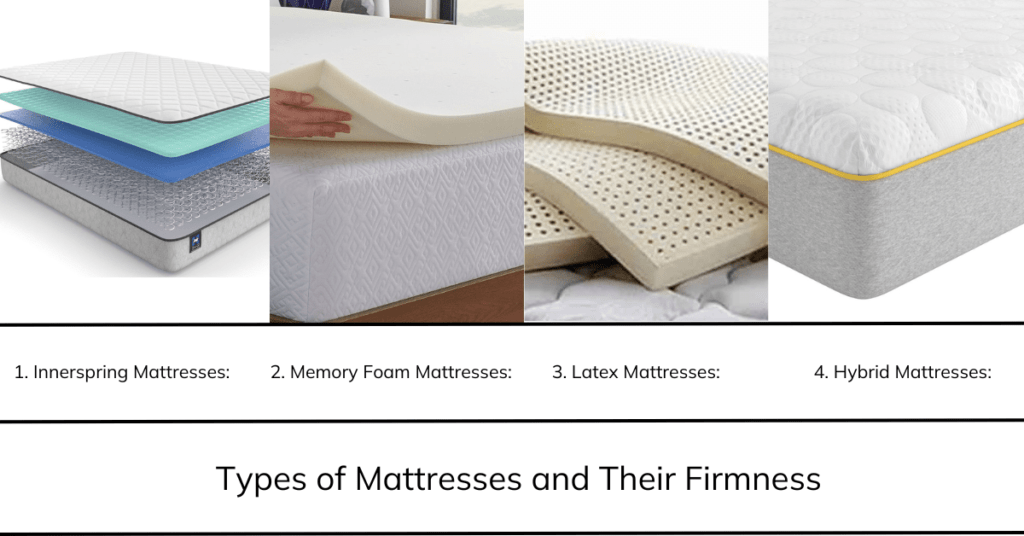
1. Innerspring Mattresses:
- Firmness: Highly variable, ranging from plush to extra-firm.
- Construction: Coils of steel provide support, with comfort layers like cotton, wool, or polyfoam on top.
- Impact on Firmness: Coil thickness and gauge (thickness of the wire) determine firmness. Thicker, heavier coils offer more support and a firmer feel.
- Unique Characteristics: Excellent bounce and airflow, good for back and stomach sleepers. May not conform well to curves, not ideal for pressure relief.
2. Memory Foam Mattresses:
- Firmness: Can range from soft to medium-firm, though typically softer than innerspring.
- Construction: Made of polyurethane foam infused with temperature-sensitive chemicals.
- Impact on Firmness: Density of the foam determines firmness. Higher density foams are firmer and more supportive.
- Unique Characteristics: Deep pressure relief, excellent for side sleepers and those with pain points. Conforms to body curves, may trap heat.
3. Latex Mattresses:
- Firmness: Can range from soft to extra-firm, offering more firmness options than memory foam.
- Construction: Made from natural or synthetic latex sap.
- Impact on Firmness: Latex density and type (Talalay is softer, Dunlop is firmer) determine firmness.
- Unique Characteristics: Excellent bounce and pressure relief, good for all sleeping positions. Sleeps cool, durable, and naturally hypoallergenic.
4. Hybrid Mattresses:
- Firmness: Wide range, combining the support of innersprings with the conforming comfort of foam or latex.
- Construction: Innerspring core with comfort layers of memory foam, latex, or other materials.
- Impact on Firmness: Depends on the specific materials and their proportions.
- Unique Characteristics: Offers the best of both worlds: support, pressure relief, bounce, and temperature regulation. May be more expensive than other types.
Practical Considerations: Balancing Budget, Durability, and Maintenance in Mattress Choice
Choosing the right mattress involves more than just finding your perfect level of comfort. Budget, durability, and proper care all play crucial roles in ensuring a satisfying and long-lasting sleep experience. Let’s delve deeper into these practical considerations to guide your mattress-buying journey.
Understanding the Budget-Firmness-Durability Triangle:
How Firm or Soft: Mattresses can be really soft or really firm, fitting different preferences and body types. Softer ones hug your body, while firmer ones support your spine better.
Money Matters: Mattress prices change a lot based on materials, brand, and how they’re made. Spring mattresses are often cheaper, but hybrids and memory foam can cost more.
How Long it Lasts: A good mattress should stay comfy for 7-10 years if you take care of it. Better quality usually means it lasts longer, but it might cost more too.
Finding the Sweet Spot:
Balancing these three factors requires careful consideration. Here are some tips:
Think about what you really need: If you’re worried about your back for a long time, a firmer mattress might be a good choice, even if it’s a bit more expensive. But if you want relief from pressure, a softer mattress could be better, even if you have to replace it sooner.
Find options that fit your budget: Not all good mattresses cost a ton. Check out reviews and comparisons online to find brands that give you a good deal. You can also look at online stores or factory outlets for possible savings.
Check for things that make it last: Look for mattresses with strong coils, dense foams, and tough covers. Using a mattress protector can also help it stay good for a longer time.
Maintenance Tips for Different Firmness Levels:
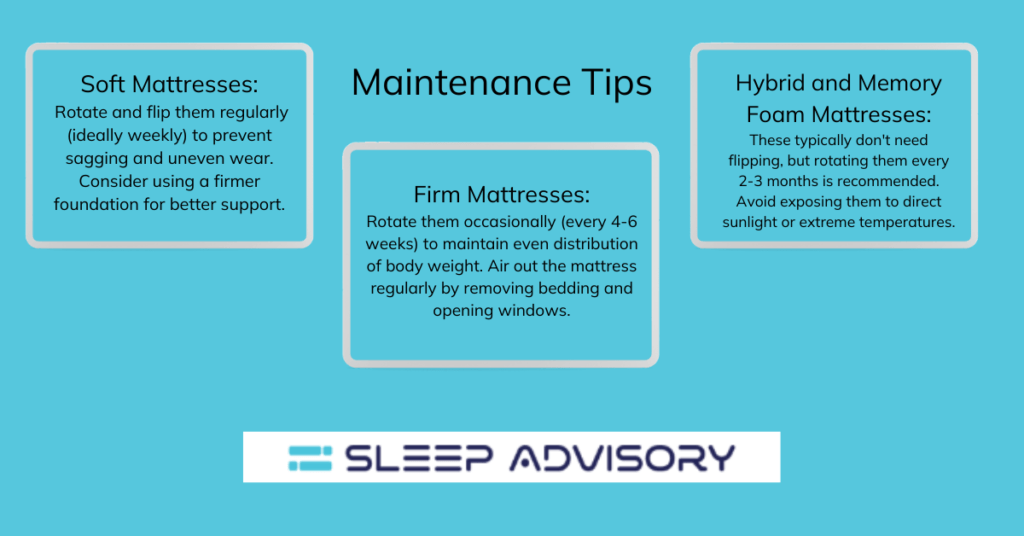
Proper care maximizes the life and performance of your mattress, regardless of its firmness. Here are some general guidelines:
Soft Mattresses: Rotate and flip them regularly (ideally weekly) to prevent sagging and uneven wear. Consider using a firmer foundation for better support.
Firm Mattresses: Rotate them occasionally (every 4-6 weeks) to maintain even distribution of body weight. Air out the mattress regularly by removing bedding and opening windows.
Hybrid and Memory Foam Mattresses: These typically don’t need flipping, but rotating them every 2-3 months is recommended. Avoid exposing them to direct sunlight or extreme temperatures.
Debunking Myths and Misconceptions: Common Misunderstandings about Mattress Firmness
When you’re picking a mattress, people often say how firm or soft it is matters most for a good sleep. But sometimes, people believe things that aren’t true, and it might make it harder to find the right mattress. Let’s clear up some common wrong ideas so you can choose what’s best for you without being misled.
Myth #1: A Firm Mattress is Always Better for Your Back
Some people think a super firm mattress is best for fixing back pain, but that’s not always true. If it’s too firm, it might hurt your hips and shoulders and make your back pain worse.
Truth is, the right firmness depends on how you sleep, your body, and what you like. If you sleep on your side, a softer mattress is good. Stomach sleepers might like it firmer for a straight back. Back sleepers usually feel comfy on a medium-firm one.
Myth #2: You Need to Replace Your Mattress Every 8 Years
This arbitrary number gets thrown around like gospel, but it’s not necessarily accurate. Your mattress’s lifespan depends on various factors, including its quality, type, and how well you care for it. A high-quality mattress can last well over 10 years, while a cheaper one might need replacement sooner.
Truth: Pay attention to signs of wear and tear, such as sagging, dips, or lumps. If you wake up with aches and pains that weren’t there before, it might be time for a change. Remember, comfort and support are key, not an eight-year deadline.
Myth #3: More Expensive is Always Better
While quality and price often correlate, it’s not always a guarantee. Expensive mattresses can be overpriced due to brand names or fancy features you might not need.
Truth: Focus on what matters to you, like materials, comfort level, and support features. Research different brands, compare prices, and rank your specific needs over inflated price tags.
Myth #4: You Can’t Flip Your Mattress Anymore
Many modern mattresses are designed to be one-sided, offering different levels of firmness on each side. Yet, some traditional mattresses still enjoy flipping to distribute wear and tear evenly.
Truth: Check your mattress’s warranty and manufacturer recommendations before flipping. If it’s allowed, flipping can extend its lifespan and maintain comfort.
Myth #5: Pillow Toppers Fix Everything
While pillow toppers can offer temporary comfort or adjust firmness slightly, they shouldn’t be a substitute for a good mattress. A poorly constructed mattress won’t be magically fixed by a topper, and it might even mask underlying support issues.
Truth: Think of a pillow topper as a temporary tweak, not a permanent solution. If your mattress needs serious help, consider replacing it instead of relying solely on a topper.
Remember, comfort and proper support are the ultimate goals, not blindly following outdated myths or marketing gimmicks.
Mattress Firmness: Beyond the Plush and Firm
We’ve explored why mattress firmness matters and how to find the sweet spot for your sleep, but what about all the cool tech and tips to make it even better? Let’s dive deeper into these bonus points:
1. Mattress Tech: Superpowers for Your Sleep
Imagine your mattress having superpowers! Newer mattresses have features like zoned support and adjustable firmness that work like magic for your body. Here’s how:
- Zoned Support: Think of your body like a map, with pressure points at your shoulders and hips. Zoned mattresses have different levels of firmness in these areas, giving your body the perfect hug where it needs it most and gentle lift where it wants space. It’s like having a built-in masseuse!
- Adjustable Firmness: Want to change things up? Some mattresses let you adjust the firmness on each side, so you and your sleep buddy can each have your own perfect sleep zone. No more fighting over the remote control for your sleep experience!
2. Testing Like a Pro: Find Your Mattress Match in the Store
Testing mattresses can be fun, but it’s important to do it right! Here’s how to be a mattress-testing champion:
- Bring your PJs: Comfort is key! Wearing comfy clothes lets you relax and feel how the mattress truly supports your body.
- Get in your zone: Lie down in your favorite sleeping positions – side, back, or even Superman if that’s your thing! Pay attention to how your body feels, especially at pressure points like shoulders and hips. Does it feel snug and supported, or are you sinking too much?
- Ask questions: Don’t be shy! Salespeople are there to help. Ask about different firmness levels, materials, and features like zoned support. They can even show you some cool tricks, like how to “bounce test” a mattress to see how well it supports your weight.
3. Foundation Matters: The Unsung Hero of Your Bed
Your mattress isn’t alone! The foundation it sits on plays a big role in how it feels. Here’s the scoop:
- Box Spring: Like a fluffy friend, a box spring adds a bit of bounce and softness to your sleep experience. It’s perfect for those who like a slightly plusher feel.
- Platform Bed: Think of it as a sturdy stage for your mattress. Platform beds offer a firmer base, ideal for back sleepers or those who want maximum support.
4. Go Green for Your Dreams: Sustainable Sleep Solutions
Caring for the planet and your sleep can go hand-in-hand! Eco-friendly mattresses are made from natural materials like organic cotton or recycled latex. They’re good for your health, good for the environment, and good for your sleep karma.
Remember, finding the perfect mattress is an adventure! Use these tips and tricks to explore, experiment, and discover your own sleep haven. Sweet dreams!
Final Word:
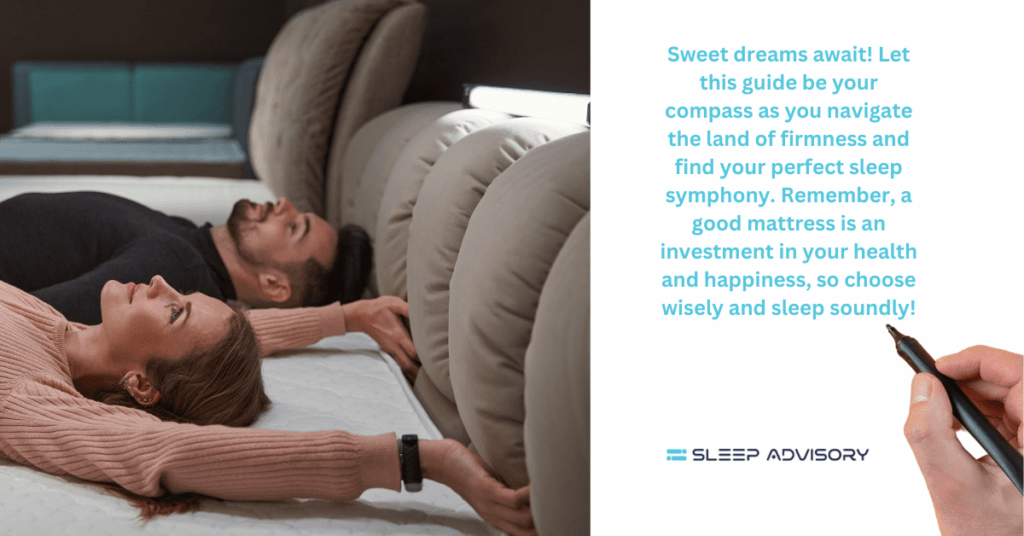
FAQs about Mattress Firmness:
1. Is there a "one-size-fits-all" mattress firmness?
No, the ideal mattress firmness varies depending on individual needs like sleeping position, body type, and personal preferences. While many people find medium-firm (5-7 on a 10-point scale) comfortable, it’s crucial to choose a firmness that supports your spine and pressure points for a good night’s sleep.
2. Are soft mattresses bad for your back?
Not necessarily. While some may need the extra support of a firmer mattress, softer options can be great for side sleepers who need pressure relief at the shoulders and hips. Ultimately, the key is to find a balance between comfort and proper alignment.
3. Can I replace pillow toppers instead of my entire mattress?
Pillow toppers can offer temporary comfort or slight firmness adjustments, but they shouldn’t be a substitute for a good mattress. If your mattress shows signs of wear and tear or doesn’t provide adequate support, replacing it is the best option for long-term health and sleep quality.
4. Is it expensive to find a good mattress?
While quality and price often go hand-in-hand, cost doesn’t always guarantee the perfect mattress. Focus on features that matter most to you, like materials, comfort level, and support functions. Research different brands, compare prices, and prioritize your needs above marketing hype.
5. How often should I replace my mattress?
It’s not just about an eight-year deadline! Pay attention to signs of wear and tear like sagging, dips, or lumps. If you wake up with aches and pains that weren’t there before, it might be time for a change. Remember, comfort and proper support are the real indicators, not a fixed timeline.
6. What's the difference between zoned support and adjustable firmness?
Zoned support mattresses have different firmness levels in different areas to address specific pressure points like shoulders and hips. Adjustable firmness mattresses allow you to manually adjust the firmness on each side, perfect for couples with different preferences.
7. Does the type of foundation matter?
Absolutely! Box springs add bounce and softness, while platform beds offer a firmer base. Choose based on your desired feel and whether you prioritize plushness or maximum support.
8. Are eco-friendly mattresses a good option?
Yes! Sustainable mattresses made from organic materials like cotton or recycled latex are good for your health, the environment, and your sleep karma. They offer comfort with a conscience.
9. How can I test mattresses effectively in a store?
Wear comfortable clothes, lie down in your usual sleeping positions, and pay attention to how your body feels (supported, pressure-free, aligned). Don’t hesitate to ask questions about different firmness levels and features. Take your time and trust your body’s feedback.
10. Where can I find more information and resources?
Look for links to sleep research organizations, industry resources, and mattress comparison tools in the article. These can provide valuable insights and help you navigate the world of mattresses with confidence.
Conclusion
Finding the perfect mattress firmness is a journey of self-discovery, not a one-size-fits-all quest. By understanding your needs, exploring different options, and prioritizing comfort and support, you can unlock the door to a world of restful nights and well-being. So, grab your PJs, embrace the adventure, and say hello to your personal sleep haven!


